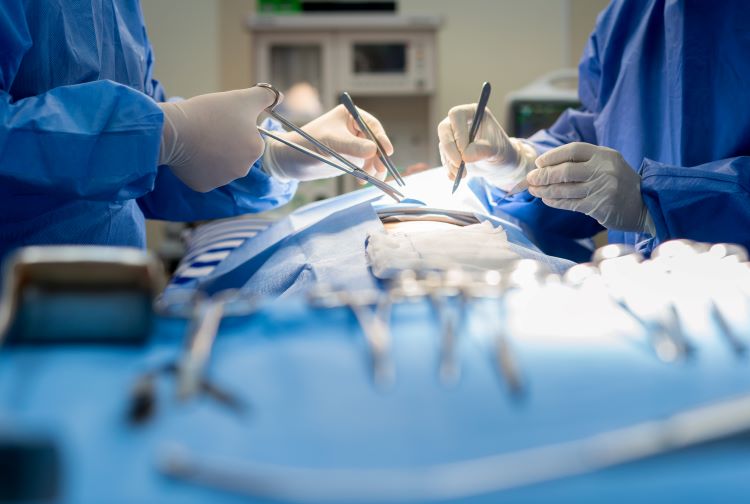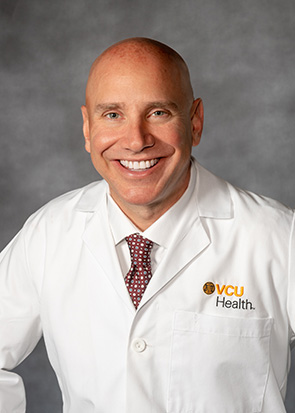
Liver transplants during COVID-19: Hume-Lee Transplant Center rises to occasion
October 16, 2020

In a new Healthy with VCU Health podcast, Dr. David Bruno, surgical director of adult and pediatric liver transplant at Hume-Lee, describes these two transplants while explaining what makes the transplant center so special.
“What’s on every liver transplant surgeon’s mind is how we can possibly help all the people on the transplant wait list and reduce the high wait list mortality we have in the United States," he says. "This is the question we’ve been consumed with for 20 years now.”
Traditional transplant approaches
The first go-to strategy is living-donor liver transplantation, in which a friend or family member with a compatible blood type donates a piece of their liver to the patient. Not only are outcomes excellent, but this method doesn’t use up a liver from the general donor pool, which relies on deceased donors.
Patients who cannot find a living donor wait their turn for a deceased donor organ. Outcomes are good, but time on the waitlist and the possibility of receiving the organ vary.
Hume-Lee innovates to find successful solutions to the organ shortage and save more lives
One of these innovations is to use livers traditionally considered “disadvantaged.” While patients are often averse to receiving a disadvantaged liver, Dr. Bruno explains why it’s still better than not transplanting a liver at all.
“I like to explain to [my patients] that they’re all used. You can’t get a new one. Some are used a little harder, and some are used not so hard. There are organs we traditionally thought were not transplantable that, in fact, are transplantable. These are organs with a little more fat in them than what’s considered a pristine organ. Or organs with hepatitis C, which is a disease that up until six or seven years ago was essentially incurable. We expand our donor pool by using these organs, and our outcomes are excellent,” he states.
Of the two innovative transplants performed during the pandemic, one was a blood type incompatible liver transplant. Blood type incompatible liver transplants are rare. Patients must overcome many immunologic problems with this kind of transplant — and the pandemic didn’t make that any easier.
“We tried to create an environment that protected our patients, because they're somewhat immunosuppressed, but at the same time allowed them to still have this lifesaving therapy,” Dr. Bruno notes.
Patients who are immunosuppressed are unable to muster the same disease-fighting capabilities as those with healthy immune systems. Extra precautions must be taken to keep these patients safe from infection.
“It was kind of our shining moment,” Dr. Bruno says. “Our nurses, physicians and providers really rallied around this patient. It's a hugely immunosuppressive regimen these patients undergo, and to do it normally is dangerous. To do it in a pandemic is certainly a really, really difficult mountain to climb. We needed to be flawless. And we were able to provide that here.”
The second transplant was a complex domino liver transplant, also rare and unique. In this case, the patient who needs a transplant has a liver that is able to be transplanted.
“It seems like a curious thing. You would think that if someone needed a liver transplant, their own liver wouldn't be useful to anyone else or would be cirrhotic or sick or scarred. But patients who are able to be domino donors and recipients at the same time are patients who have various defects that aren't focused in their liver. When we transplant them, we're trying to provide what their old liver couldn’t,” Dr. Bruno explains.
Despite pandemic, Hume-Lee meets the challenges to save two lives
“I think these two cases would be unique [regardless], but in the midst of a global pandemic, it's a stunning achievement. At the beginning of the pandemic we all had to ask ourselves the question, especially in liver transplantation, about whether or not we were going to stop doing transplants. Most of our patients have very, very little time. Weeks, maybe. They're incredibly sick, and they would suffer,” Dr. Bruno shares. “The answer we came up with was really simple: These patients aren't going to be around when the global pandemic is over, and we don't know when the global pandemic is going to be over.”
For additional information about liver transplantation at VCU Health, visit the VCU Health Hume-Lee Transplant Center. To hear an in-depth conversation on this topic with Dr. Bruno, please listen to this podcast.



